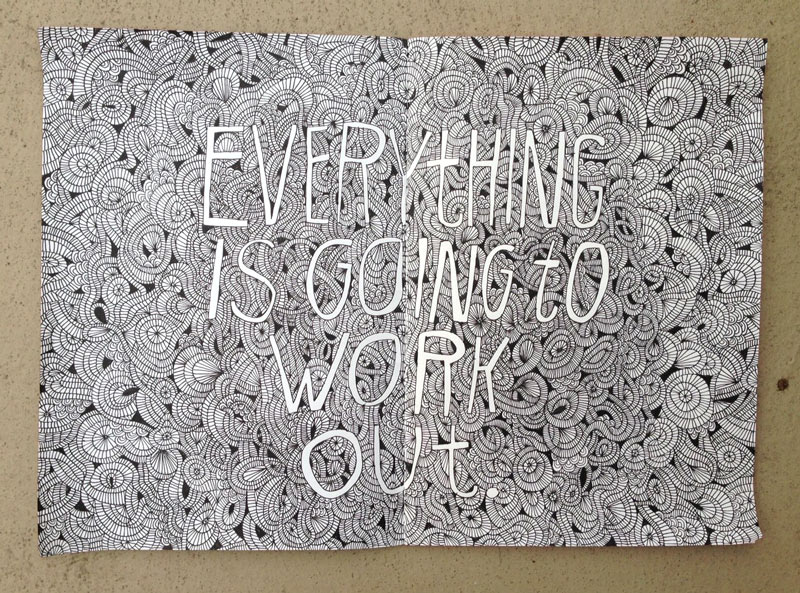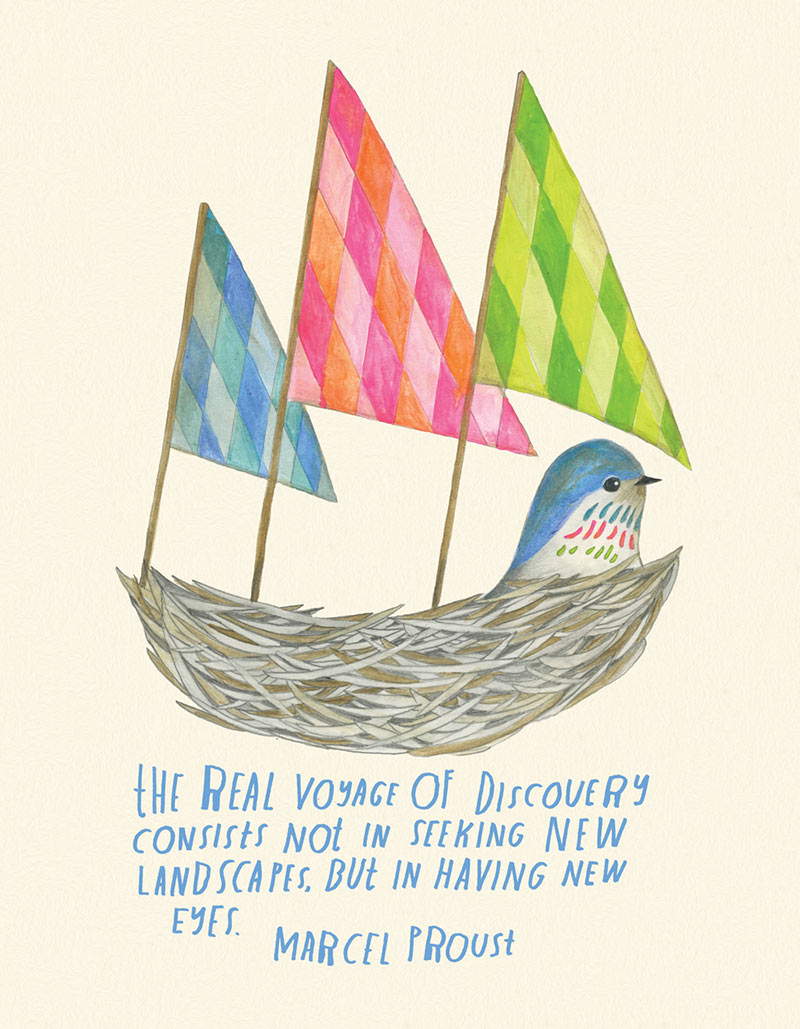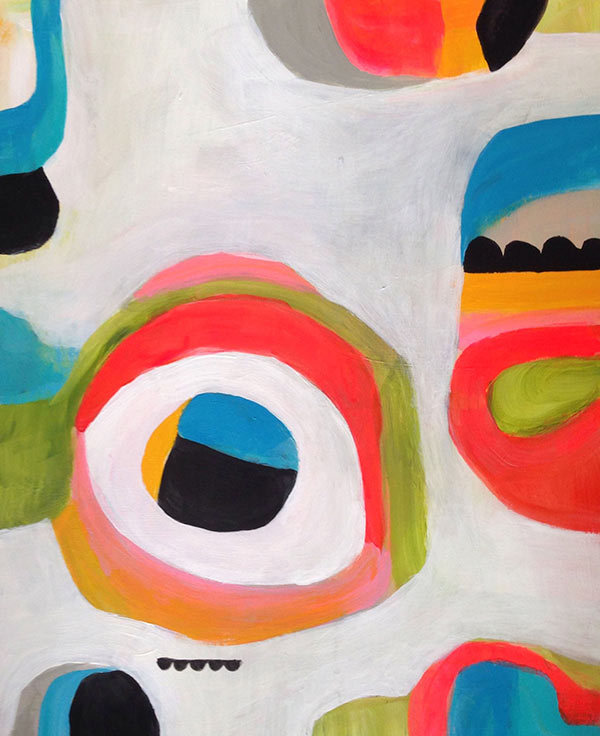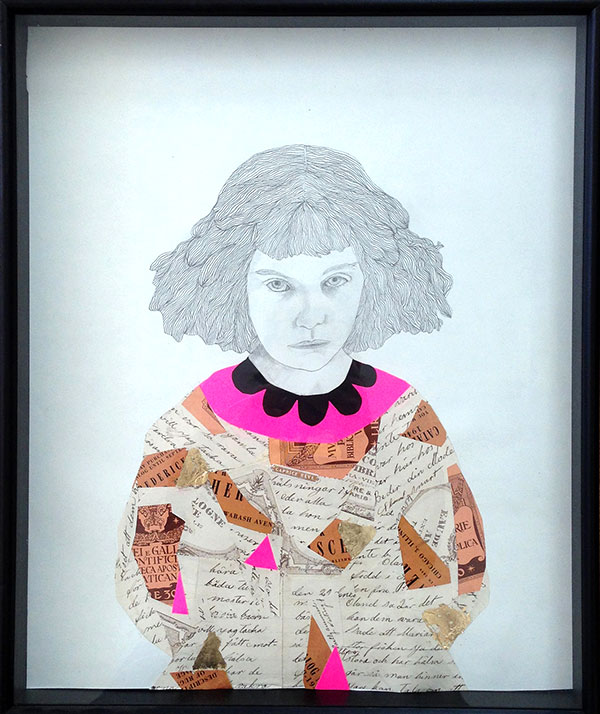Behold the power of the paintbrush. At age 31 this small tool changed Lisa Congdon’s life forever. While she occasionally draws on her former life as an educator – authoring books and giving lectures – these days Lisa can usually be found toiling in her Oakland studio making illustrations, paintings and drawings, and serving as inspiration for us to quit our day jobs and pursue our passions.


Sketchbook Spread, Ink on Paper, 2013
We were so surprised to find out you didn’t start making art until you were in your 30s, and you were never officially trained as an artist. Can you tell us a little about that, and how you got into the profession?
I was working in the world of education, first as a teacher and then in a non-profit organization. Along the way, when I was about 31, I took a painting class for fun. It changed my life. I started making art as a hobby, dabbling in all sorts of mediums, and making very ugly things at first. But I loved it. And so I did it all the time when I wasn’t at work, and I became obsessed with making art. I took a few classes, but most of what I did came out of just experimenting and practicing after I got home from work and on the weekends. By the time I was 38 I started showing and selling my work and when I was 39 I left my job to become self-employed. I struggled for a few more years, but I kept at it and eventually I began to make a solid full-time living from my work and my career really took off in a big way.


Voyage of Discovery
Watercolor and Ink on Paper
2013
Do you think you would have been a different kind of artist if you had gone to art school?
Maybe. I think my aesthetic was formed fairly early on when I was in my 20s and early 30s – even before I started making art. It was formed just going through life as a young person in San Francisco and being exposed to all kinds of things – art, fashion, design, food, culture. And so early on, I had a strong sense of style – in terms of what I wore, the art I chose to buy, how I decorated my home, etc. All of that filtered into the kind of art I made when I started to paint and draw at 31. So sometimes I wonder if I had gone to art school early on in college or in my early 20s if I would have encountered other influences and have a completely different style. One thing I know for sure is that I would have more technical skill. When you are self-taught you always sort of do things in a wonky way. I know this from talking to other self-taught artists.
What was going through your head when you decided to leave your job, one that you had worked hard for and that paid well, in order to become an artist?
Oh, lots of fear and anxiety. I mean, I was excited, but I was also incredibly nervous. I didn’t want to blow it. I had a great job with great pay and benefits. I knew what I was giving up. That said, I knew I was ready. It was very clear that this was what I wanted to do, even though at the time I wasn’t making enough money to support myself. And I was single at the time too, which made it more challenging. But I scraped by and made it work. It took me about three years of struggle after I left my job before I began to make a regular income from my work. But when you want something badly enough (for me it was both art and self-employment) you work your ass off for it.
It was as if I snuck into a party I wasn’t invited to, and I thought that eventually I’d be caught and kicked out for not having any real talent.
Was it hard for you to see yourself as a real artist at first? And what kind of pressures did you feel from your creative community?
Yes, and honestly I have just started to feel like a “real artist” for the first time in the last two years, even though I have been showing and selling my work for about eight years. I have given talks and written essays on my blog about the fact that I felt like an imposter for a long time. And honestly, that was not because of how the creative community was treating me. For the most part, everyone in the community treated me with so much respect. It was more a self-inflicted insecurity I felt because the art and illustration worlds were so mysterious to me. It was as if I snuck into a party I wasn’t invited to, and I thought that eventually I’d be caught and kicked out for not having any real talent. I’ve learned that’s a very common feeling among self-taught artists and people who have made their way into the art world through non-traditional channels.
How important was the Internet in your journey to becoming a full-time illustrator?
These days I make about 50 percent of my income from illustration, about 30 percent from fine art, and 20 percent from other areas (teaching, speaking, writing). And the Internet has been extremely important in leading to all of that. I would not be where I am without the Internet. One of the advantages to becoming an artist when I did, which was in the early 2000s, was the Internet was becoming this important platform for creative people to share their work. I mean, not nearly in the ways it is now, but it was all starting then. And I got in on it early. I was an early adopter of Flickr and blogging, which were two ways I initially began to build a community online back in 2004, to meet people, share pictures of my work, etc. And initially it was all just for fun. It was a hobby. Then in about 2006 everything changed. People started wanting to buy my work, asking me to participate in group shows, reading my blog, that kind of thing. I started gaining an online presence, followers, clients, customers. By 2007 I left my job. I still hadn’t reached a steady line of work, but I was on my way.
It’s important to remember that the Internet can only work for you as an artist if you make a concerted effort to put your work out there and use it strategically. And I did that. There were times I felt like a pimp. And it was exhausting. Thankfully, I don’t feel as much that way anymore. Blogging, Instagram, Twitter and Facebook are all things I do now to keep my business alive, and I am grateful for them. I like all of those platforms a lot, especially blogging and Instagram. I can show stuff I’m interested in, stuff I’m making. I get to just be myself and do what I like to do, and then share bits and pieces of my life and my studio practice.


Permutation
Acrylic on Wood
2014


Hand lettering for Airbnb.com, 2014
Did you take any steps to promote yourself besides having an online presence?
I have always worked hard to build my portfolio and a strong website, which I continue to update every couple years. In fact, right now I’m in the process of designing my fifth website since 2006. I also regularly make contact with people and galleries and residencies I am interested in working with. I think that is a form of promotion for sure.
Can you talk a little bit about the dynamic between your illustration work versus your personal fine art?
Ah, well, it used to feel like this horrible tension. But I have worked hard over the past few years to hone my voice so they all feel cohesive and part of the same family – even though they are quite different. My fine art now mostly consists of abstract paintings and my illustration work is more representational stuff, repeat patterns and hand lettering. There are definitely iconic colors and shapes, markings and line that you see in both my fine art work and my illustration work. So even though they’re different, they are part of the same family. And I am rarely bored because of the diversity in my practice.
I think diversifying your art practice is a great way to increase the chances you have steady income as an artist.
When did you get to a point where you were able to say no to projects, and what kinds of projects do you turn down?
I hit this point in 2011 when projects started coming in pretty regularly. I’d been working at my career for many years, and had even had an illustration agent since 2008. So it was a relief to finally get a steady flow of work. But inevitably, when your work receives more demand, there is really no way to take every single opportunity, and so you have to say no to some projects. I have this sort of internalized set of criteria that I’ve been using for the past few years, and generally when an opportunity comes my way, I weigh it against the criteria. Lots of factors come into play – money, resonance, good aesthetic match, timing (how tight are the deadlines). So I generally turn down jobs, gallery opportunities or commissions that don’t pay well, where I don’t see good alignment aesthetically between what the client represents and my artwork or where it just looks like I won’t have time to do the job based on my existing commitments. Sometimes I say yes because an opportunity is so awesome, even if on paper I don’t have time. Sometimes you just have to make things work.


Stillness
Acrylic on Canvas
2014
Can you tell us a little about diversifying your income as an artist?
I have always had a diverse set of income streams. I make and sell original works and work with galleries, which is my fine art practice. I sell prints online. I do commercial illustration – editorial, book, surface design. I license my work. I teach. I write. Now I am doing public speaking. I think diversifying your art practice is a great way to increase the chances you have steady income as an artist – to the extent you can achieve your goals as an artist. Also it keeps things interesting. Sometimes it’s overwhelming to be managing so many things, and sometimes I fantasize about being just a painter. But I’d probably get bored.
What steps do you take to keep your passion for education, and contributing to something beyond your practice?
I teach fairly regularly, give lectures and take most opportunities to speak publicly about being a working artist and about my creative process. I wrote a book called Art Inc., which came out in 2014, and it’s about building your career as an artist. I never really thought that my art practice would lead to this book or to contributing to the conversation about making an income as an artist or dispelling the starving artist myth. But here I am, and it feels good to be giving back in this way to artists who are just starting out.
Shit takes time. Keep working hard, don’t give up, and be patient.


Sarah
Graphite and Cut Paper
2014
What sorts of places do you go to, or look to, if you get stuck?
When I get stuck, I usually just stop and take a break from what I am doing. Sometimes when you are working on deadline you don’t have the luxury of walking away for too long, but even a few minutes helps. Often getting stuck just means you are hating on your own work, because it isn’t what you thought it would be (and you’ve already been working on it for five hours straight). And sometimes just walking away, even for 15 minutes, helps. I walk a lot, sometimes I pace, or I clean, or distract myself in some other way, or talk to my studio mate about my frustrations. And then when I come back to it, I am not so stuck.
Is there a type of work you’d like to get your hands into?
I have been wanting to get into designing housewares and home décor. I recently got a gig designing dishware for a major company, and so I’m getting my hands dirty with that for now.
Looking back, do you wish you started making art earlier?
Sure, of course. But I also recognize that I wouldn’t be where I am without every experience in my life that came before the age of 31 when I first picked up a paintbrush. And in some ways I feel that I was had an advantage starting my art career in my late 30s. I had already learned so much about the way the world works.
What’s the biggest lesson you’ve learned along the way?
Shit takes time. Keep working hard, don’t give up, and be patient. There is light at the end of every tunnel.


Bandana Design for Nativen, 2014
The Smell of Chlorine, Watercolor on Paper, 2014
Hand Lettered Quotation, 2014